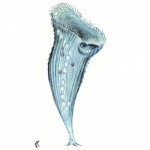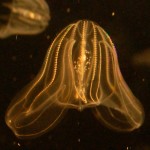 There were two prominent themes to end the year in BMC Biology – cell geometry, on which we launched a new series; and – entirely fortuitously – the evolution and development of eyes, on which as it happens we had an interesting diversity of research submissions.
There were two prominent themes to end the year in BMC Biology – cell geometry, on which we launched a new series; and – entirely fortuitously – the evolution and development of eyes, on which as it happens we had an interesting diversity of research submissions.
Sizing up cell geometry
It can be easy to forget just how complex the architecture of a cell is, with size, shape, cell division, and both internal and external organisation needing to be delicately controlled to produce the correct result. Wallace Marshall highlighted just how little we know about many of these subjects in an opinion article last year, and our Cell Geometry series, which has launched this month, now aims to address just these sort of questions. Among the new contributions is a lively and varied Forum discussing how cell size is controlled, with contributions from experts working on a number of systems including bacteria, yeast, plants and worms. As might be expected from such a wide sampling of the domains of life, the answer to the question “What determines cell size?” turns out to be “It depends what you are,” with every organism apparently having idiosyncrasies. Research papers on the evolution of intracellular traffic and the architectural athletics involved in the folding of embryonic epithelia give some indication of the scope of the questions the series will address.
Among the new contributions is a lively and varied Forum discussing how cell size is controlled, with contributions from experts working on a number of systems including bacteria, yeast, plants and worms. As might be expected from such a wide sampling of the domains of life, the answer to the question “What determines cell size?” turns out to be “It depends what you are,” with every organism apparently having idiosyncrasies. Research papers on the evolution of intracellular traffic and the architectural athletics involved in the folding of embryonic epithelia give some indication of the scope of the questions the series will address.
Eyes lost and eyes regained
Animal eyes are hugely diverse, and so a topic of perpetual interest to biologists – not least in terms of how they develop and even, in some cases, regrow. The axolotl is a salamander often used as a model for studying regeneration because of their ability to regrow lost limbs and tails. Unlike some other amphibians, however, it had seemed that they couldn’t regenerate eyes – or lenses to be precise. But as this new paper shows, we’d just been looking at the wrong time, and while adults can’t regenerate the lens, it can occur – and by a novel mechanism – shortly after hatching.
 A more ancient link to eyes is found in a genomic analysis of opsins and photoproteins in bioluminescent ctenophores (or comb jellies), which catalogues the existence and organisation of a number of photoprotein genes in this non-bilaterian taxon – and concludes that photoproteins arose in the common ancestor of all animals. Accompanying experiments to detail the expression of these genes suggest that opsins and photoproteins are coexpressed in certain cells, leading the authors to raise the possibility of a link between light generation and detection in these bioluminescent animals.
A more ancient link to eyes is found in a genomic analysis of opsins and photoproteins in bioluminescent ctenophores (or comb jellies), which catalogues the existence and organisation of a number of photoprotein genes in this non-bilaterian taxon – and concludes that photoproteins arose in the common ancestor of all animals. Accompanying experiments to detail the expression of these genes suggest that opsins and photoproteins are coexpressed in certain cells, leading the authors to raise the possibility of a link between light generation and detection in these bioluminescent animals.
And finally to missing eyes in cave animals, a classic example of regressive evolution, or the loss of traits in environments where they are no longer useful. Traditionally the loss had been presumed to be neutral evolution due to disuse, but more recently it has been suggested that eyes are actively selected against – and new research from the Jeffery lab seems to back up that idea. Genetic analysis of hybrids between Astyanax cavefish and their surface fish relatives suggests that vibration-seeking behaviour – a good way to navigate in the dark cave environment – is subject to a trade-off with eye size, as the eye orbit is instead used for the vibration-sensing cells.
And more…
Contributions unrelated to neither eyes nor geometry include Dominic Norris on cilia and left-right asymmetry, Robert May on how man-made extinctions are unique – and how they’re not, Rogier Sanders commenting on a new protein designed to disable HIV via a “one-two punch” (the original paper is in Retrovirology), and research from the Ebert lab on sex-specific parasite adaptations when one host sex is more common than the other.
Kester Jarvis
Latest posts by Kester Jarvis (see all)
- The agony of choice: conservation biology and choosing what to save - 18th March 2014
- Sigma factor networking and bacterial versatility - 30th January 2014
- Electricity generation and fish populations: how a power station provided a rich biological dataset - 4th September 2013
Comments